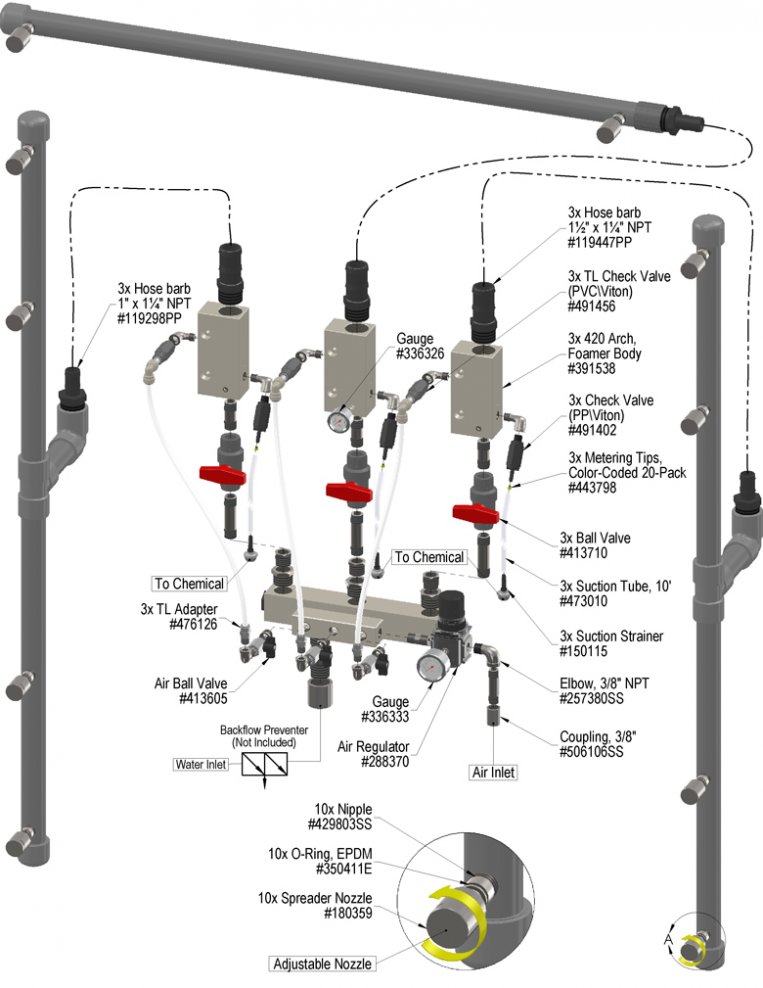| Water | |
| Temperature | up to 160°F |
| Pressure | 40 - 125 PSI |
| Flow | 7.35 GPM @ 40 PSI (total) 2.45 GPM @ 40 PSI (per bar) |
| Hose/Pipe | 1-1/2" |
| Compressed Air | up to 12 CFM |
Side bar lengths and nozzle placement can be factory customized at the time of order
Requirements
| Water | |
| Temperature | up to 160°F |
| Pressure | 40 - 125 PSI |
| Flow | 7.35 GPM @ 40 PSI (total) 2.45 GPM @ 40 PSI (per bar) |
| Hose/Pipe | 1-1/2" |
| Compressed Air | up to 12 CFM |
Side bar lengths and nozzle placement can be factory customized at the time of order
Overview
Safety & Operational Precautions
To Install (refer to diagram on next page)
If you are connecting to a potable water supply follow all local codes for backflow prevention.
Set the chemical dilution ratio by threading one of the color coded metering tips into each chemical check valve. See chemical labels for dilution ratio recommendation or consult your chemical supplier.
TO FOAM
Always make sure the foam bar is connected and pointed in a safe direction before turning water and air on. DO NOT kink the hose to stop foam flow, return to the unit and turn off water and air supplies
Metering Tip Selection | ||
|---|---|---|
Metering Tip Color |
OZ/MIN |
Dilution Ratio |
Brown | 0.56 | 560:1 |
Clear | 0.88 | 356:1 |
Bright Purple | 1.38 | 227:1 |
White | 2.15 | 146:1 |
Pink | 2.93 | 107:1 |
Corn Yellow | 3.84 | 82:1 |
Dark Green | 4.88 | 64:1 |
Orange | 5.77 | 54:1 |
Gray | 6.01 | 52:1 |
Light Green | 7.01 | 45:1 |
Med. Green | 8.06 | 39:1 |
Clear Pink | 9.43 | 33:1 |
Yellow Green | 11.50 | 27:1 |
Burgundy | 11.93 | 26:1 |
Pale Pink | 13.87 | 23:1 |
Light Blue | 15.14 | 21:1 |
Dark Purple | 17.88 | 18:1 |
Navy Blue | 25.36 | 12:1 |
Clear Aqua | 28.60 | 11:1 |
Black | 50.00 | 6:1 |
| No Tip Ratio Up To: | 6:1 | |
| The dilution ratios above are approximate values. Due to chemical viscosity, actual dilution ratios may vary. | ||
Formula | ||
|
GPM × 128 ÷ Desired Dilution Ratio = oz/min
| ||
Unit Flow Rates | |
|---|---|
| PSI | GPM |
| 40 | 2.45 |
| 50 | 2.74 |
| 60 | 3.00 |
| 70 | 3.24 |
| 80 | 3.46 |
| 90 | 3.68 |
| 100 | 3.87 |
| 110 | 4.06 |
| 120 | 4.24 |
| 125 | 4.33 |

Troubleshooting Guide |
|---|
| Problem | Possible Cause / Solution | |
|---|---|---|
| Startup | Maintenance | |
| A) Foam surges and/or hose "bucks". B) Foamer will not draw chemical. C) Foam too wet. D) Foam does not clean properly (too dry). E) Using too much chemical. F) Water/chemical backing up into air line. G) Water backing up into chemical container. H) Air/chemical solution backing up into water line. | 1, 2, 3, 4, 6, 7, 8, 9, 10 1, 3, 4, 7, 8, 9 2, 3, 4, 6, 7, 8, 9, 10 1, 4, 6, 11 5 |
12, 13, 14, 15, 16, 18, 19 12, 13, 14, 15, 16, 18, 19 13, 14, 15, 16, 18, 19 17 18 20 |
| Possible Cause / Solution | |
|---|---|
| Startup | Maintenance |
|
|
PREVENTIVE MAINTENANCE: When the unit will be out of service for extended periods, place chemical tube(s) in water and flush the chemical out of the unit to help prevent chemical from drying out and causing build-up. Periodically check and clean chemical strainer and replace if missing. |